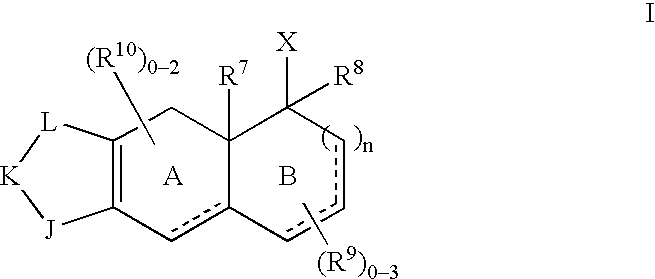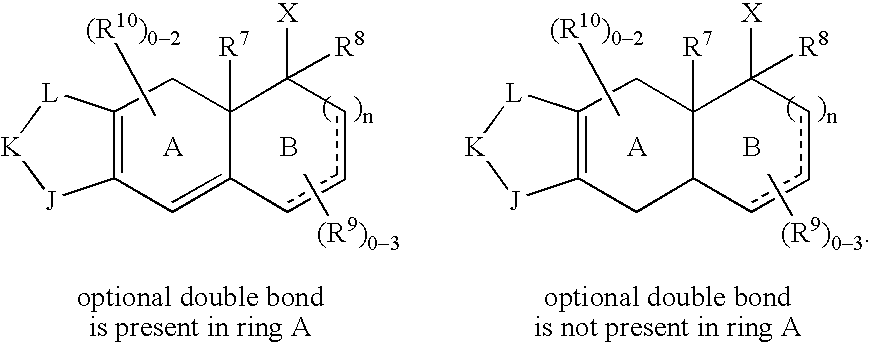Selective non-steroidal glucocorticoid receptor modulators
a non-steroidal, selective technology, applied in the direction of extracellular fluid disorder, immunological disorder, metabolism disorder, etc., can solve problems such as problems affecting ancillary pharmacology
- Summary
- Abstract
- Description
- Claims
- Application Information
AI Technical Summary
Benefits of technology
Problems solved by technology
Method used
Image
Examples
example 1
[0409]
[0410]COMPOUND A (1.0 g, 3.53 mmol) was dissolved in 10 mL of anhydrous THF under argon atmosphere and cooled to −50° C. Then 4.0 equiv of phenylethynyl magnesium bromide (1M in THF, 14.12 mmol, 14 mL) was added dropwise. The resulting reaction mixture was then allowed to slowly warm to 23° C. over 6 h. The reaction was quenched with 100 mL of saturated aqueous NH4Cl, extracted with methylene chloride (3×75 mL) and the result organic layers were dried over sodium sulfate and evaporated under reduced pressure. The crude reaction mixture was purified by flash column chromatography (SiO2, EtOAc / hexanes) to give the desired product as a yellow foam. The product was characterized by 1H NMR, HPLC and mass spectroscopy (m / z: 385 (M++1)).
example 2
[0411]
[0412]EXAMPLE 1 (408 mg, 1.41 mmol) was dissolved in 10 mL EtOAc and 10% Pd / C (100 mg) was added. The reaction mixture was stirred under hydrogen atmosphere (1 atm) for 20 min before it was filtered through celite, washed with EtOAc (50 mL) and evaporated under reduced pressure. The crude reaction mixture was purified by flash column chromatography (SiO2, acetone / hexanes) to give the desired product as a pale yellow foam. The product was characterized by 1H NMR, HPLC and mass spectroscopy (m / z: 389 (M++1)).
Compound I
[0413]
[0414]2,4-Dichlorophenethyl alcohol (10 g, 52.0 mmol) was dissolved in 100 mL of methylene chloride, cooled to 0° C. under nitrogen atmosphere and 1.5 equiv of phosphorous tribromide (1M in CH2Cl2, 80 mmol, 80 mL) was added dropwise. The resulting reaction mixture was warmed to 23° C. and stirred for 2 h before the very slow addition of 200 mL of saturated aqueous sodium bicarbonate and extraction with methylene chloride (2×150 mL). The combined organic layer...
example 3
[0417]
[0418]COMPOUND A (100 mg, 0.336 mmol) was dissolved in 2 mL of anhydrous THF under an argon atmosphere and 3.0 equiv anhydrous CeCl3 (1.0 mmol, 246 mg) was added and the resulting suspension was placed in a sonicator at 23° C. for 30 min followed by additional stirring (1 h). This reaction mixture was then cooled to −30° C. and 3.0 equiv of a solution of COMPOUND II (0.5 M in THF, 1.0 mmol, 2 mL) was added. The resulting reaction mixture was allowed to slowly warm to 23° C. over 15 h. The reaction was quenched with 35 mL of IN HCl, extracted with methylene chloride (3×20 mL) and the result organic layers were dried over sodium sulfate and evaporated under reduced pressure. The crude reaction mixture was purified by flash column chromatography (SiO2, EtOAc / hexanes) to give the desired product as a yellow foam. The product was characterized by 1H NMR, HPLC and mass spectroscopy (m / z: 457 (M++1)).
Compound III
[0419]
[0420]Lithium aluminum hydride (65 g) was suspended in dry THF (1....
PUM
| Property | Measurement | Unit |
|---|---|---|
| temperature | aaaaa | aaaaa |
| pressure | aaaaa | aaaaa |
| temperature | aaaaa | aaaaa |
Abstract
Description
Claims
Application Information
 Login to View More
Login to View More - R&D
- Intellectual Property
- Life Sciences
- Materials
- Tech Scout
- Unparalleled Data Quality
- Higher Quality Content
- 60% Fewer Hallucinations
Browse by: Latest US Patents, China's latest patents, Technical Efficacy Thesaurus, Application Domain, Technology Topic, Popular Technical Reports.
© 2025 PatSnap. All rights reserved.Legal|Privacy policy|Modern Slavery Act Transparency Statement|Sitemap|About US| Contact US: help@patsnap.com



